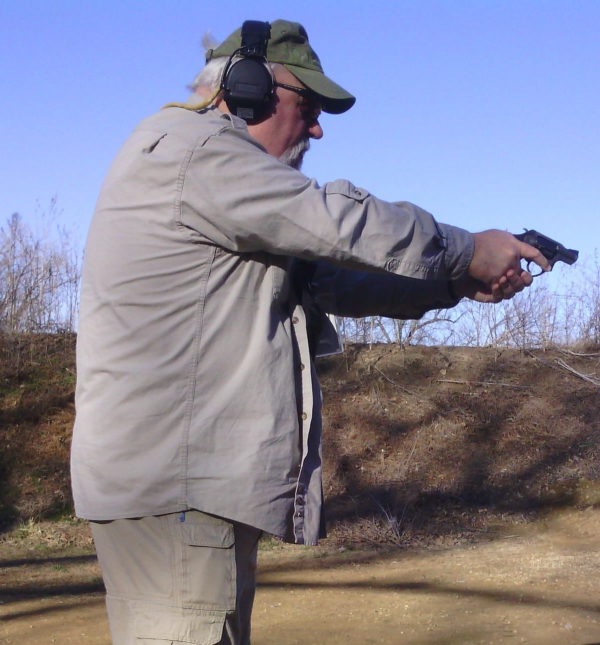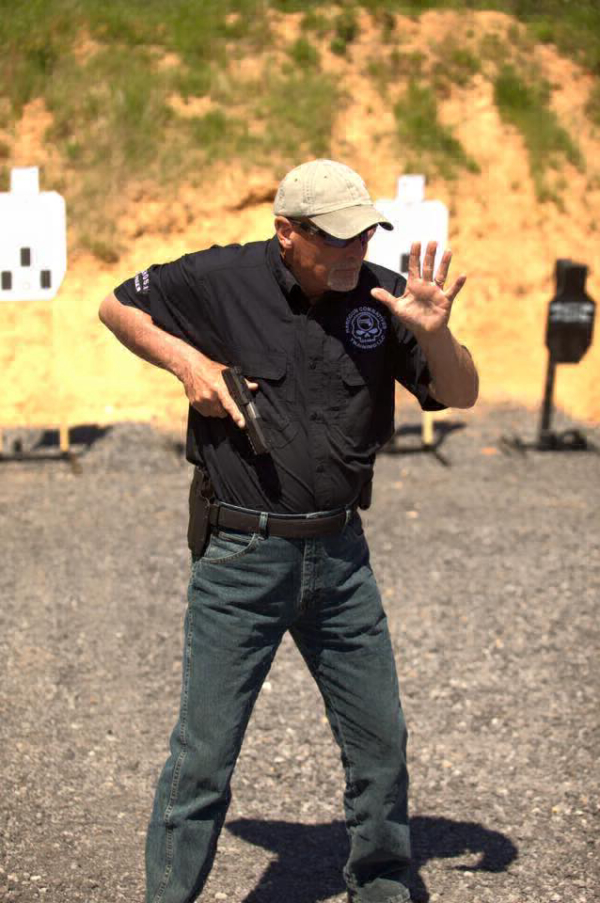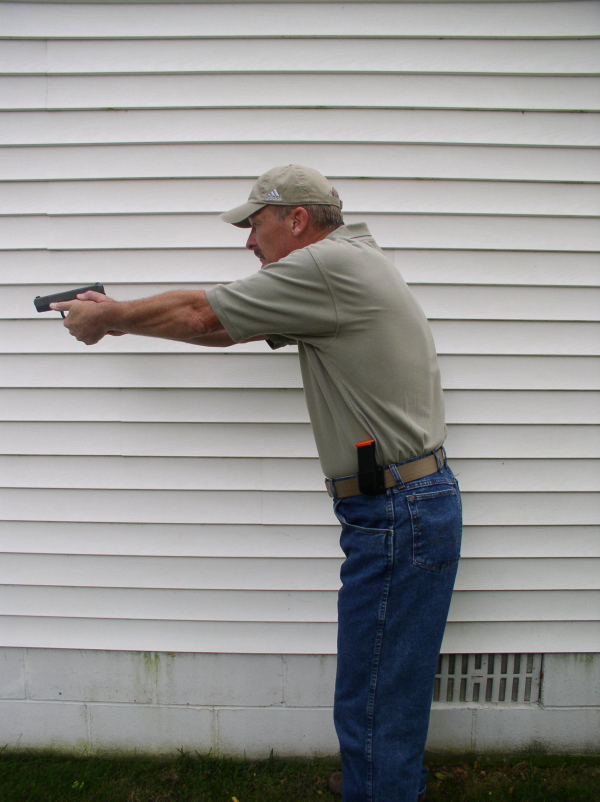Today’s feature is from correspondent Dave Spaulding.
Ready: adjective \ˈre-dē\: prepared to do something, properly prepared or finished and available for use, almost about to do something
Prepare: verb/ pre·pare \pri-ˈper\: to make (someone or something) ready for some activity, purpose, use, etc., to make yourself ready for something that you will be doing, something that you expect to happen, etc., to make or create (something) so that it is ready for use.

While “ready” and “prepare” are similar, when it comes to the positioning of your combat handgun they should not be viewed as the same. In true READY, the gun is oriented in a position in which it can be fired with minimal motion as nothing else will do in the tight time frame and distances of pistol combat. In a PREPARATORY position, the gun is out of the holster but held in a position that keeps persons around the shooter safe in the event of a negligent discharge. It’s more about diverting the muzzle than being prepared to fight. An important point: If the gun is not oriented in a position that would allow the “safe” discharge of a round then don’t use it! This includes both bystanders and the person holding the handgun.
I have had the good fortune to attend courses held at the best shooting facilities and by the best-known travelling instructors and all had a signature or preferred ready position. There is nothing wrong with this but it should also be understood that no single ready position will work for all situations. How could it? Conflict is fluid by nature and the threat(s) will move and so should the orientation of the gun. We have known since the days of The Spartans that the person who will win in a fight is not the fastest or most accurate, but the one who has the proper state of mind ... he who can control panic ... and can adapt the quickest to the rapidly changing situation and muzzle orientation must be part of this change/adaptation.
In my classes, I taught what I called “The Arc of Ready” which was a battery of three Ready Positions that can be adapted with minimal motion but change the forward orientation of the muzzle dramatically. They can also be used with one or two hands, which is important. While few students believed it at first, I made the point that one ready position was not appreciably faster than the next and then I demonstrated by shooting each position at 20 feet into a heart sized target using an electronic timer as the start signal. I could usually deliver an accurate hit in the .5 to .7 second region and, considering it takes between .22 and .27 to hear and react to the beep of the timer, this leaves around .4 to .6 second for a response and shot. Considering the blink of an eye is .32 second, this is a minimal response time and I am quite satisfied with it.

It is essential for the reaction/response time from ready be as fast as possible for obvious reasons. Recently the Force Science Institute undertook a study looking at various trigger finger and ready positions to see if one was faster than another. Their results were quite interesting. Here are the main points from this study. If you want to read the entire report, it can be found through their website.
Force Science reported the results of the study in their newsletter. Their findings?
1. That trigger finger placement off of the trigger matters when the index finger is positioned to rest on the pistol slide- that’s slower, according to their study samples, than other options (index finger straight alongside the trigger guard, the same with finger bent against the trigger guard front, above the trigger guard along the frame and “high register” – finger straight resting on the slide.
2. Tactical ready positions were studied, including the following: pistol held behind the leg (“bootleg”), “belt tuck” where the gun is at navel level and pulled into the body, close-ready -where the gun is higher than the belt and pulled in with muzzle downward, high ready (slightly depressed muzzle), low-ready (aimed down at a 45° angle and “temple index” (high-guard, one-handed next to the head.) High ready was fastest, “bootleg” and “high-guard” were contrastingly slower – when aiming. Without aiming (!), the fastest was low-ready. Researcher Lewinsky noted, "the handgun timings indicate that the closer the ready position is to a final firing position, the faster the officer is likely to be in getting off his first round."
3. He also noted that “more important than improving the mechanics of weapon craft is teaching officers to read potentially hazard scenarios early on, so they can detect threat cues quicker and better anticipate an adversary's actions, thereby getting ahead of the reactionary curve before the crisis point. "Without that skill," he says, "they're likely to end up so far behind the action that things like the most desirable finger indexing and ready positioning won't really matter."
As always, Force Science has done a thorough job but some of their muzzle positions do not differentiate between a ready and prepare which is of critical importance. What they call The Boot Leg (something I have never taught but seems to occur with many police officers regardless of training) is certainly a preparatory position and if I am reading it correctly so is the “Belt Tuck” which seems to be similar to SUL. Their “Close Ready” I call a Compressed Low Ready while their High Ready is also known as the Guard Position as made popular by Jeff Cooper. Their Low Ready is aptly named and is the most popular/utilized position while The High Guard I have always known as The Temple Index and is also considered a preparatory position.


The reason I consider the Boot Leg, SUL and the Temple Index Preparatory Positions is due to the orientation of the muzzle off the threat zone/battle space for safety purposes while the various Ready Positions orient the gun in a fast-fighting posture toward the threat. As Dr. Lewinsky stated, the further away from a fighting posture the gun is, the slower it will be into action which is certainly a matter of common sense, though common sense isn’t always “common” …
I did not teach any of the Preparatory Positions listed in this study (though I have seen them used in my programs) as I feel they are not as efficient as what I taught. I taught what I called a Ribcage Index in which the gun is held in the shooting hand only with the thumb flagged and the wrist locked orienting the muzzle down. In this position, the gun can easily be defended and is oriented in a position in which I would be willing to discharge a round into the ground. As a matter of fact, I have done this on multiple occasions demonstrating where the round will strike, which is in a two-to-three-foot circle around my feet. Are you willing to do this with the gun held in SUL, Boot Leg or Temple Index? If not, don’t use it as that is why you are diverting the muzzle. Another thing I like about the Ribcage Index is it is consistent with other movements I make. The position is nothing more than stopping along the arc of the draw stroke, meaning I can easily re-holster, go into a weapon retention firing position or a full extension of the arms in the same practiced manner as if I hadn’t paused at the rib cage. It also keeps my support hand free to fend, fight or just push someone out of the way…something that cannot be done when the hand is buried under the gun. Continuity of action/motion is important when building skill.

Whichever you choose, understand the difference between a Ready and Preparatory Position and use them wisely. Make the motions when moving from one to another smooth, minimal and efficient and you will find you place yourself at a minimal disadvantage in a high threat zone. Adaptation is the key and the proper use of any Ready or Preparatory Positions will help you prevail when your life's on the line.
Dave Spaulding is a professional firearms instructor with 36 years' experience in law enforcement and federal security. The recipient of the 2010 Law Enforcement Trainer of the Year Award from the International Law Enforcement Training and Educators Association, Dave has worked in all facets of law enforcement including communications, corrections, court security, patrol, evidence collection, training and investigations. He was a founding member of his agency’s SWAT Team and acted as its training officer for 8 years. He spent a year in an undercover capacity and was the commander of a multi-jurisdictional narcotics task force, has been an adjunct instructor at the former Heckler & Koch International Training Division and the Tactical Defense Institute. In addition to his many published articles (over 1,400), Dave is the author of two acclaimed books, Defensive Living and Handgun Combatives. He operated his own training company with focus on “the combative application of the handgun” www.handguncombatives.com.